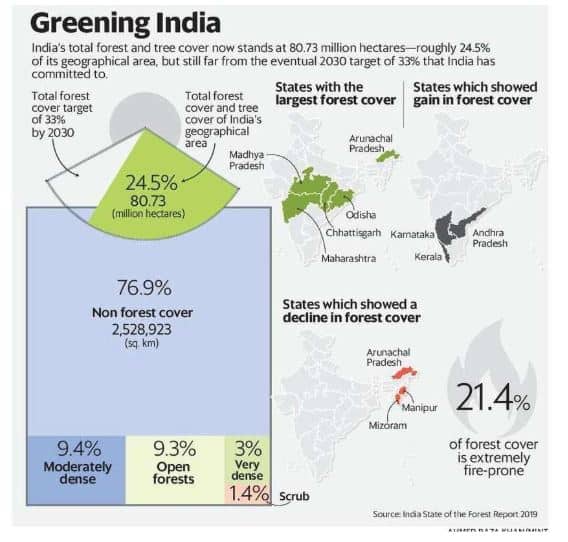UPSC Articles
Environment
Topic:General Studies 3:
- Conservation, environmental pollution and degradation, environmental impact assessment
Daily Current Affairs IAS | UPSC Prelims and Mains Exam – 22nd January 2020
What is the state of forests in India?
Context:
The India State of the Forest Report 2019 was released recently which shows that India has increased its forest cover
About India State of the Forest Report (ISFR)
- ISFR is a biennial publication of Forest Survey of India (FSI), an organization under the Ministry of Environment Forest & Climate Change.
- The ISFR assesses the forest and tree cover, bamboo resources, carbon stock and forest fires.
- The 2019 report for the first time has assessed the qualitative nature of the forest cover, including listing its biodiversity and the type of plants and trees found.
- It also created a national forest inventory for the first time on produce from forests.
Some of the findings of the report
- India’s forest cover has increased by 3,976 sq. km since 2017—a rise of 0. 56%.
- Tree cover—tree patches of size less than one hectares outside the recorded forest areas, also showed a rise, albeit a little higher at 1.29%
- India’s total forest and tree cover now stands at 80.73 million hectares—roughly 24.5% of its geographical area, and still far from the eventual target of 33%, which India has committed to raise to, by 2030.
Concerns expressed by ecologists are:
- Definition of Forest Cover
- Forest Survey of India defines forest cover as “all patches of land, with a tree canopy density of more than 10% and more than one hectare in area, irrespective of land-use, ownership and species of trees”—an assessment relying majorly on satellite mapping.
Counter Arguments:
- Therefore, then any fruit garden, coconut or coffee plantation, or even urban parks would come under ‘forest cover’
- Such a definition will give incomplete picture of our Natural forests, especially with regard to what is happening in Western Ghats & Himalayan Forests
- Blame on Forest-dwelling communities
- FSI’s new study to assess the dependence of people, living in over 170,000 ‘forest fringe villages’, states that this dependence could be a “major driver of impairment of forest productivity”
Counter Arguments
- These communities have been living in harmony with nature since centuries and dependent on forests for their livelihood. Coexistence with nature and not competition with the nature is their way of life
- However, the big impact areas—the diversion of forest land for roads, dam projects— has been completely disregarded while putting blame on these communities
- Compensatory Plantation
- Compensatory plantation done to replace the original, natural forests during diversion of forest-lands for projects have so far yielded no impactful results.
- Some of these new areas were even earmarked for other projects or expansion of existing ones, even though they remain under government’s Recorded Forest Area (extent of forests in terms of legal status).
Way Ahead
- Changing the definition of Forest Cover: Instead of just canopy cover or hectares, the need is to focus on what is a ‘thriving forest’ or an ‘ecosystem
- Real time spatial data of our forest land. share those maps in real time so we know where we are losing our forests.
- Any afforestation activity undertaken must include an adaptation programme in the light of Climate Change, else the exercise will be futile
- To stop the fragmentation of forests—especially a problem in the North-East where forest cover is declining—so that forest areas remain connected to form one big habitat
Do You Know?
- Forests are sink and reservoirs of carbon, thus critical in adaptation to climate change.
- As part of its climate action plan, India has committed to create an additional carbon sink of 2.5-3 billion tonnes of CO2-equivalent through additional forest cover and tree cover by 2030.
Connecting the Dots:
- Other findings of the State of Forest report 2019
- Kasturirangan and Gadgil Committee report on Western Ghats
- Environmental Impact Assessment














